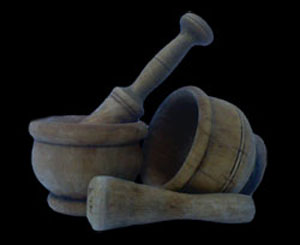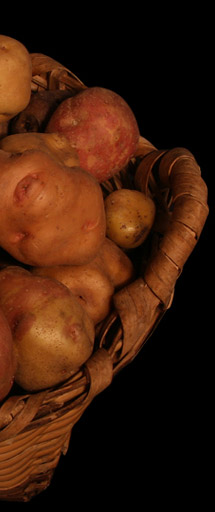The potato in the canary cuisine and its companion, the ‘mojo' .
“...Hero of the subterranean night,
endless treasure of the people,
hunger's enemy of all the nations...”
Pablo Neruda.
In this broad gastronomy we can't forget the aromatic herbs and spices which contributes to the exotic touch found in the elaboration of dishes as in ‘mojos', sauces and dressings or prickling. Within the most common are the red pepper, the majoran, the parsley, the thyme, the laurel and the saffron, which besides giving taste and aroma, they have beneficial effects to health. Also not to forget are other usual elements, like male vinegar (a traditional product became famous in our kitchens thanks to the present restless vintners), salt pepper, paprika, garlic, olive oil, water and breadcrumbs. We call ‘mojo' to some of the typical sauces of the Canary Islands , indispensable accompaniment of some typical foods of this archipelago. Due to its content in pepper, many of the typical ‘mojos' are hot, but there are all sorts. The origin of the word mojo is not still clear, but there is a Portuguese word from which it could come: molho, what mans sauce. There are lots of mojos inherit between families, where each one has a particular elaboration. Even though, not always it turns out the same. At the lack of any ingredient of the recipe, improvisation is typical in the Canarian kitchen. But for sure there will come out an original and exquisite dish, although it differs a bit from the original conception of this sauce. 
The Canarian kitchen has also got place for innovation. There we can see the fried mojo, mojo with eggs, with cheese, boiled tomato mojo, one with green peppers, with red ones (which doesn't become sweet but neither hot), the one with chitterlings, for dishes with goat or rabbit.
Its utility is to streng and increase the taste of some dishes or products. Otherwise there are other variants like the cheese mojo, typical from La Palma and El Hierro, and the Almogrote, from La Gomera. They combine cheeses with mojo to get a paste, which is more liquid on the first ones while the Almogrote is more consistent. The different kinds of mojos depend of its main ingredient. The most popular are the coloured mojo (red or hot) and the green one, but each has its special features since they could be made of parsley, coriander, red pepper, paprika, etc.
Normaly the red mojo goes with meat while the green with fish, as the red and the white wine in the same way. Anyway, this rich Canarian sauces are worthy of having to with any food. Since ever, the white wine traditionally been in the south of Tenerife , while the red in the north, up to Icod de los Vinos, where already were the two variants. Anyway the red wine traditionally has had its importance the area of Tacoronte.
To speak about the potato is, for sure, to speak about the mojo. From the ones we have commented, the most known are the ‘mojo picón' (spicy) and the coriander mojo, about which are spoken later.
In the mojo contests carried out by the association, it was considered to interpret three groups: green, red and special mojos. Within each group are non-spicy, little spicy and spicy or hot.
We neither forget other traditional foods which go with the potato or vice versa. A field partner, already commented in previous paragraphs, for long time sharing the same water and the same fertilizer or manure. Of course we refer to the vine. The wine, a partner of many dishes of our kitchen, as many are the stocks offered by this land. Yesteryear, the wines weren't taken according too the grape variety nor depending what was demanded from each dish. It was more common to take the famous Tacoronte wine with a good fish from the Prix, or a Taganana wine with a good cod, or a white wine from Icod de los Vinos with any good food. But nowadays it is chosen by the best accompanying wine. The different themes of these pages will be carried through our partner and friend Dolores, who will advice us continually with recipes shown on our web. As well the site ‘Dolore's things' contains culinary curiosities, anecdotes, etc. Also we expect on counting with the help of her husband, from which we thank for his advices and his wine skills. Our partner will have support and contribution from her restaurateur friends, housewife, amateurs, association members, and whoever share recipes and general information.
The potato is one of the most consumed goods on the islands. In fact, comparing it with other Spanish regions, it's here were it is most consumed. It is a basic element in the Canarian cuisine, also high valued as side dish on a wide range of plates.
The famous wrinkled potatoes are the indisputable complement of all ‘mojos'. They've got in common its easy elaboration and peculiar taste. 
Wrinkled potatoes:
- Wash the new potatoes and put them into the caldron.
- Fill the caldron with water until the potatoes are covered, just letting show a bit of the upper ones.
- Add 3-5 handful salt, covering the potatoes.
- Boil until soften, pricking with a fork till it goes in easy.
- Take off the fire and drip the water into the sink. Then leave it on the fire for a few more seconds, moving the boiler to avoid burnings. So you remove the wet appearance.
- Serve on a plate or bowl, so the get that characteristic colour with the air contact.
Later some comments will made about the wrinkled potatoes, because the way to prepare could vary. For example some people add a cabbage leaf or a lemon to accentuate the flavour.
Mojo Picón

The ‘mojo picón' (spicy mojo) is one of the elements of Canarian gastronomy, best known out of our frontiers, since it is one of the most attractive specialities of our kitchen . Faithful companion of the typical table. It is necessary to consider that there won't be two equal mojos, because some have a particular elaboration, so you can find oceans of tastes. That's why giving the recipe of the ‘mojo picón', we will see the ingredients are not of exact measure. Some put a thing more than other with the same recipe. Remind that the canary is able to draw a mojo from the little that he may have.
Checking Web pages, there no equal recipe. In that way we are showing one of so many could shown. We restrain in the most common elements, as in approximate quantities.
[
See Ingredients ]

Source:
• La Fundación para la Etnografía y el Desarrollo de la Artesanía Canaria FEDAC
• Papas Antiguas de Canarias
• Asociación de Papas Antiguas de Canarias



